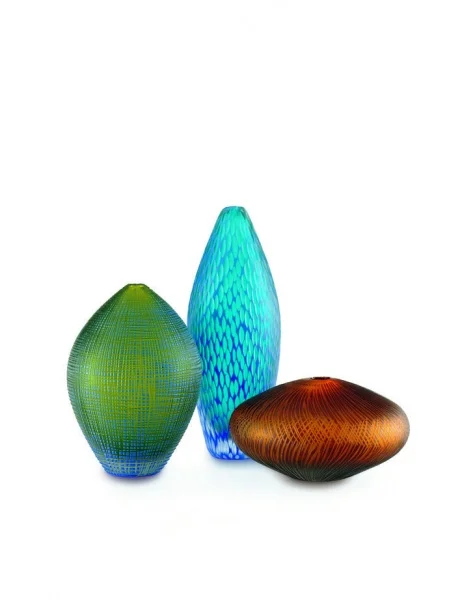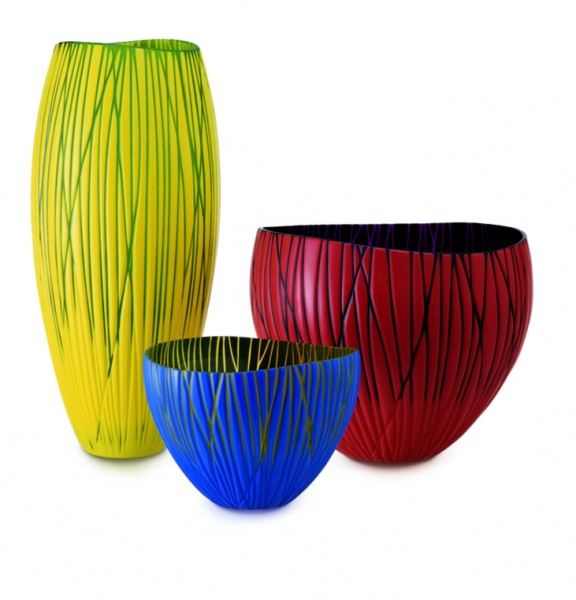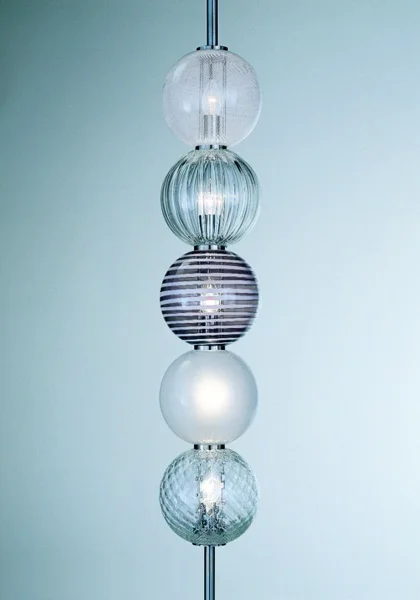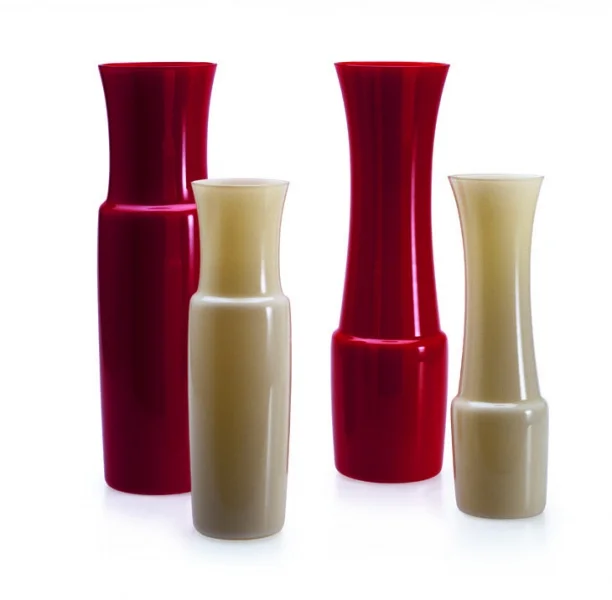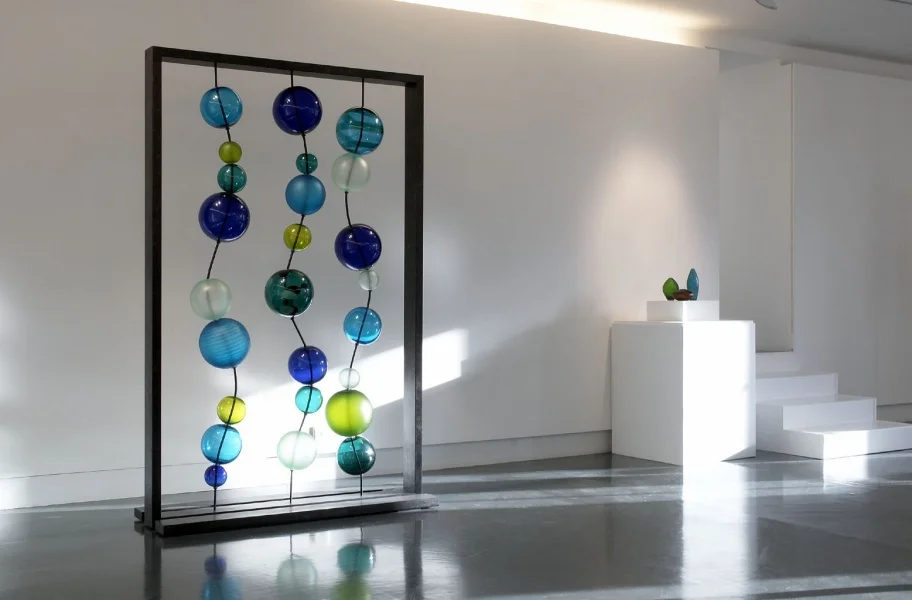Venini - The Heart of Glass
By Roberto Gasparotto
For “Circus of Spheres”, the Venini part of the catalogue
I was struck by the mysterious plasticity and the clean lines of the works of Monica and Philip from the very first time I saw them in Frankfurt in 1994. A mixture of Nordic severity and Mediterranean colour, it was difficult to define which tradition the works actually belonged to, for they seemed to bring together the rational characteristics of the Scandinavian tradition and the superb craftsmanship of the Master glass-blowers in Murano. I was therefore very keen to bring these artists into the Venini experience, which traditionally, has always looked beyond the excellence of its craftsmanship, in order to grow in a more rational experience, nearer to a Nordic vision of production. Venini, from its origins, has always been atypical of Murano, as it has long welcomed artists from the world of industrial design, ever since they started to establish themselves throughout central Europe in the early 1920s. What was particularly striking, right from the beginning, was the double role shared by these two artists: they have both the ability to design and a deep understanding of the techniques, which is concretely reflected in the realisation of their ideas and projects
I had previously admired some of their works in art galleries in Paris and New York, where it was obvious that the artists’ serious professional approach and the quality of the execution they had already achieved, made their works comparable to others of a high cultural level. I was able to identify some clear influences: on the one hand, Carlo Scarpa, who in the 1930s was the first to adopt the Venetian “cold” techniques of battuto, inciso and grinding, thereby offering one of the most beautiful exaltations of Murano glass: on the other hand, Tapio Wirkkala who, with his techniques of incalmo and hot filigree, created some of the best works of the 1960s and 1970s. The experience of these two great masters of 20th century Applied Arts is recomposed and finds new expression in the works of Monica and Philip, who add their own great sensitivity for colour, a love of contrast between transparency and opacity, as well as a masterly interpretation, based on their real and concrete technical knowledge.
As we stood for the first time together next to the Venini furnace in Murano, I noticed that although very knowledgeable about production techniques, in their relationship with the Master glass-blowers and grinders, they showed humility, a desire to collaborate and a passion to learn new secrets. It seemed as if they had all been working together for a long time: common experience, the exchange of concrete ideas and the manual processes had immediately built a climate of complicity and a close rapport dominated by a passion for glass. Subsequently, each time they met, they produced highly artistic prototypes of rare beauty. These objects seemed to originate from very simple, pure forms, which were, in turn, able to generate families of objects: pleasing to the eye, sensual to the touch and deformed in such a way as to stretch out into space, making their bases seem almost incredible or impossible.
In the ‘Ebano’ (Ebony) project, a series of bowls designed for our production, the bases, which were invisible and incomprehensible, were created by grinding away glass produced with a cold technique in order to transform the tangential point of the ‘nut’ of glass into a thin, short, flat surface which, thanks to its grinding, produced a point of translucence that generated an extraordinarily beautiful chromatic effect when seen from above.
From the very first I was moved by the ability to conceive of objects which allow the transparent under layers to emerge through their opaque surfaces. The precise incisions, made according to the texture and a series of geometric patterns, are softened, both on the surfaces and in their chromatic contrast, by a manual velato finish, producing, yet again, extremely refined results. The ‘Topkapi’ project is only one of many examples which uses this technique in a masterly way: the vases are so small that they seem almost useless, but so beautiful that they become indispensable.
Light, whether natural or artificial, and the quality of receiving or transmitting it, plays a fascinating role and itself becomes an element of the design of Monica and Philip, who are able to create objects which come alive thanks to their transparency and the transformations that they undergo as light passes through them.
This is evident in ‘I Fili di Arianna’ (Ariadne’s Thread) project, a series of vases and cups, which due to the dimensions of their apertures, allow light to filter through the vitreous mass, thereby highlighting the contrast between the interior and exterior, obtained by the different techniques of shiny-interior, incised-exterior.
Or in the ‘Abaco’ (Abacus) project where the internal illumination exalts the selection of techniques utilised for creating the different spherical elements which form the whole object, as though they were in themselves a demonstration of all the expressive possibilities.
Furthermore, with the ‘Dorici’ (Dorics), even when using less complex techniques such as mould blowing, they have shown a great ability to find those shapes which are able to enhance the potential of the technique itself.
Finally, last year Monica and Philip started what is perhaps their first large scale project, creating in ‘Circo di Lune’ (A Circus of Moons) actual walls where they bring together all their ideas, thereby creating an object which is able to live alone, to accept creations in different scales and to build the space around it, of which it is always the protagonist.
The characteristic feature of this project is its ability to define the relationship between full/empty, closed/open, opaque/transparent and the harmony of the ever-changing dimensions of spheres which sinuously penetrate into the frame made of iron, a material which is in strict contrast to the ethereal refinement of the suspended moons. The various chromatic combinations, in red/orange, green/blue and black/white, and the techniques of glass making are the fundamental elements of the project from an expressive point of view, and once again of the ability to use filtered light as a component of the final elaboration.
To complete everything, there is also the fundamental element which Monica and Philip possess: a strong sense of humanity and professional correctness, accompanied by enthusiasm and a willingness to collaborate on a technical level, which are all indispensable premises for the creation of works that obviously originate in the heart, and which will surely make Monica and Philip protagonists of 21st century glass-work.
Architetto Roberto Gasparotto
Artistic Director Venini 2004


